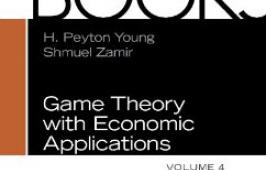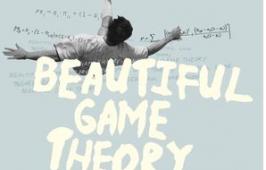Game Theory & Graphs
Graph-theoretic models for multiplayer games - known as graphical games - have nice computational properties and are most appropriate for large population games in which the payoffs for each player are determined by the actions of only a small subpopulation.
Related posts
|
From theory to application One of the most common online activities is search. Large companies, such as | READ MORE ... |
Book In everyday life we must often reach decisions while knowing that the outcome | READ MORE ... |
Article We study the evolution of imitation behaviour in a differentiated market where | READ MORE ... |
|
Article We conduct a laboratory experiment with a constant-sum sender–receiver game and | READ MORE ... |
Article We conduct a laboratory experiment and provide evidence of learning spillovers | READ MORE ... |
Article We present an application of lattice theory to the framework of influence in | READ MORE ... |
|
Book "A beautiful dozen. Twelve papers presented in 20 years of meetings of the | READ MORE ... |
From theory to application It is well known that some diseases have a genetic origin, often originated by | READ MORE ... |
New book Key environmental issues, such as biodiversity and climate change, have in | READ MORE ... |
|
FEEM RE3 Article Approaching the complexities inherent in human behavior, and compounded by the | READ MORE ... |
Article A game with precedence constraints is a TU game with restricted cooperation, | READ MORE ... |
Blog This blog offers an interesting view on sports and their statistical and | READ MORE ... |
|
This mini-course was presented by Myrna Wooders at the 2014 International Game | READ MORE ... |
Working paper This paper provides a game-theoretical analysis of the use by athletes of | READ MORE ... |
This year's Nobel prize in economic sciences goes to Prof. Jean Tirole of | READ MORE ... |
|
New book The ability to understand and predict behavior in strategic situations, in | READ MORE ... |
Working paper We provide a tractable concept that can be used to study the influence of the | READ MORE ... |
Working paper Using a network approach we provide a characterization of a separating | READ MORE ... |
|
Working paper We illustrate an equivalence between the class of two-person symmetric games | READ MORE ... |
Working paper Multinational companies can shift profit and income between branches in order | READ MORE ... |
MobLab is a recently released software for teaching abstract concepts in | READ MORE ... |
|
Working paper This paper introduces a general framework for dealing with dynamic | READ MORE ... |
Working paper The primary question in coordination games concerns the possibility of | READ MORE ... |
Working paper This paper considers the estate division problem from a non-cooperative | READ MORE ... |
|
Working paper We consider a cheap-talk setting that mimics the situation where an incumbent | READ MORE ... |
Article Consider a setting in which agents can take one of two ordered actions and in | READ MORE ... |
Article In this paper we distinguish two competing conceptions of dignity, one | READ MORE ... |
|
Book A wealth of research in recent decades has seen the economic approach to human | READ MORE ... |
Article We consider a two-player contest model in which breakthroughs arrive according | READ MORE ... |
Article This note analyzes a two-player all-pay auction with incomplete information. | READ MORE ... |
|
Article We consider a two-player all-pay auction with symmetric independent private | READ MORE ... |
Article The paper aims at generalizing the notion of restricted game on a communication | READ MORE ... |
Article Geography and social links shape economic interactions. In industries, schools | READ MORE ... |
|
Working paper We develop a modification of the connections model by Jackson and Wolinsky (1996 | READ MORE ... |
Working paper Scheduling jobs of decentralized decision makers that are in competition will | READ MORE ... |
Working paper Calculating explicit closed form solutions of Cournot models where firms have | READ MORE ... |
|
Working paper We consider a model of dynamic price competition to analyze the impact of | READ MORE ... |
Working paper We study a stochastic model of influence where agents have yes-no inclinations | READ MORE ... |
Working paper We study innovation contests with asymmetric information and identical | READ MORE ... |
|
Working paper There are many situations in which individuals have a choice of whether or not | READ MORE ... |
Working paper In a model with finitely many agents who have single-dipped Euclidean | READ MORE ... |
Working paper We provide epistemic conditions for correlated rationalizability, which are | READ MORE ... |
|
Working paper This paper analyses the problem of aggregating judgments when strategic voters | READ MORE ... |
Working paper In a model of stochastic costly signaling in the presence of exogenous | READ MORE ... |
Working paper Several relaxations of Nash equilibrium are shown to exist in strategic games | READ MORE ... |
|
Working paper Two main school choice mechanisms have attracted the attention in the | READ MORE ... |
Working paper A model of belief dependent preferences in finite multi-stage games with ob- | READ MORE ... |
Working paper Inspired by the behavior in repeated guessing game experiments, we study | READ MORE ... |
|
Working paper We consider agents whose language can only express probabilistic beliefs that | READ MORE ... |
Working paper Collective decisions are modeled by preference correspondences (rules). In | READ MORE ... |
Working paper We prove the existence of a subgame-perfect "-equilibrium, for every | READ MORE ... |
|
Working paper |
Working paper We study bankruptcy games where the estate and the claims have stochastic | READ MORE ... |
Working paper Given a graph with nonnegative edge weights and node pairs Q, we study the | READ MORE ... |
|
Working paper The paper concerns a model of influence in which agents make their decisions on | READ MORE ... |
Working paper This paper introduces the notion of nested best response potentials for | READ MORE ... |
Working paper We study a framework where two duopolists compete repeatedly in prices and | READ MORE ... |
|
Working paper Curb sets [Basu and Weibull, Econ. Letters 36 (1991), 141-146] are product sets | READ MORE ... |
Working paper This note shows that every finite game of strategic complementarities is a | READ MORE ... |
Working paper In a Bayesian game some players might receive a noisy signal regarding the | READ MORE ... |
|
Working paper In this paper, we present a bounding methodology that allows to compute a tight | READ MORE ... |
Working paper We consider any network environment in which the “best shot game” is played. | READ MORE ... |
Working paper We introduce a description of the power structure which is inherent in a strate | READ MORE ... |
|
Working paper The three-in-a-tree algorithm of Chudnovsky and Seymour decides in time O(n4) | READ MORE ... |
Working paper We give a structural description of the class C of graphs that do not contain a | READ MORE ... |







